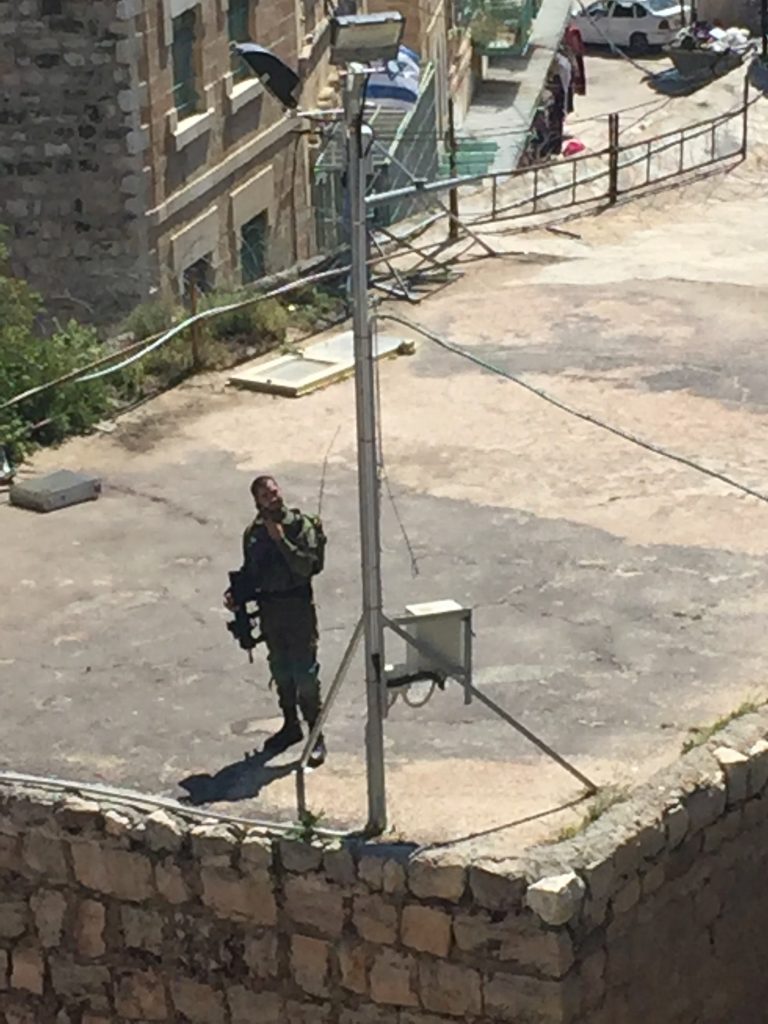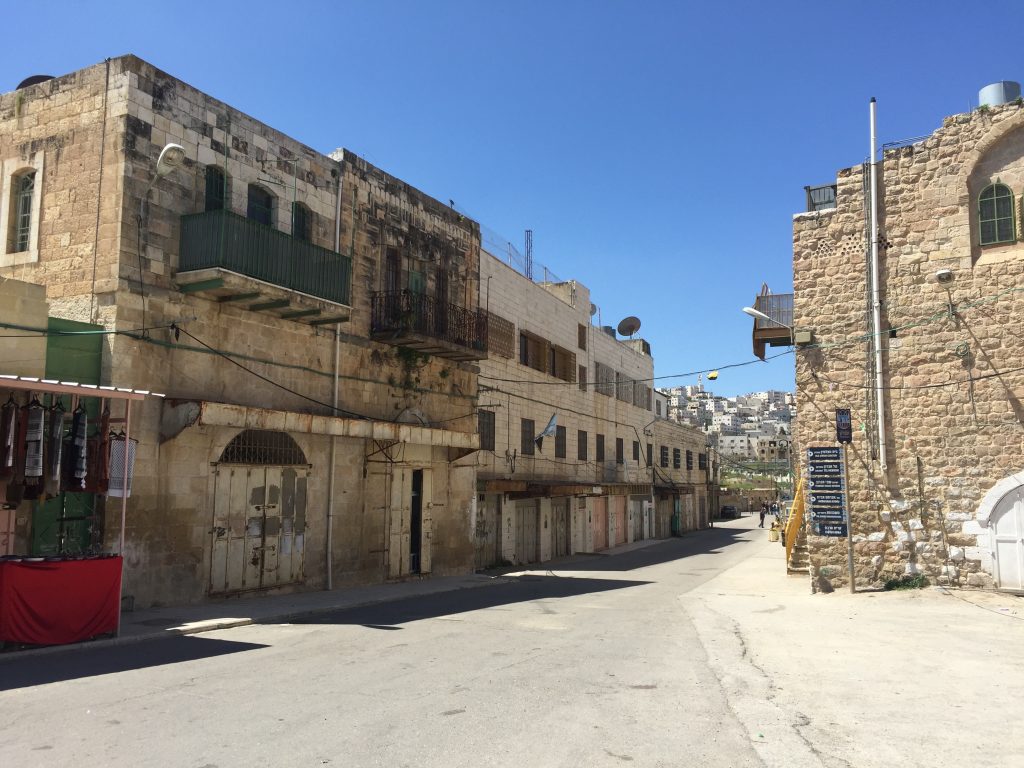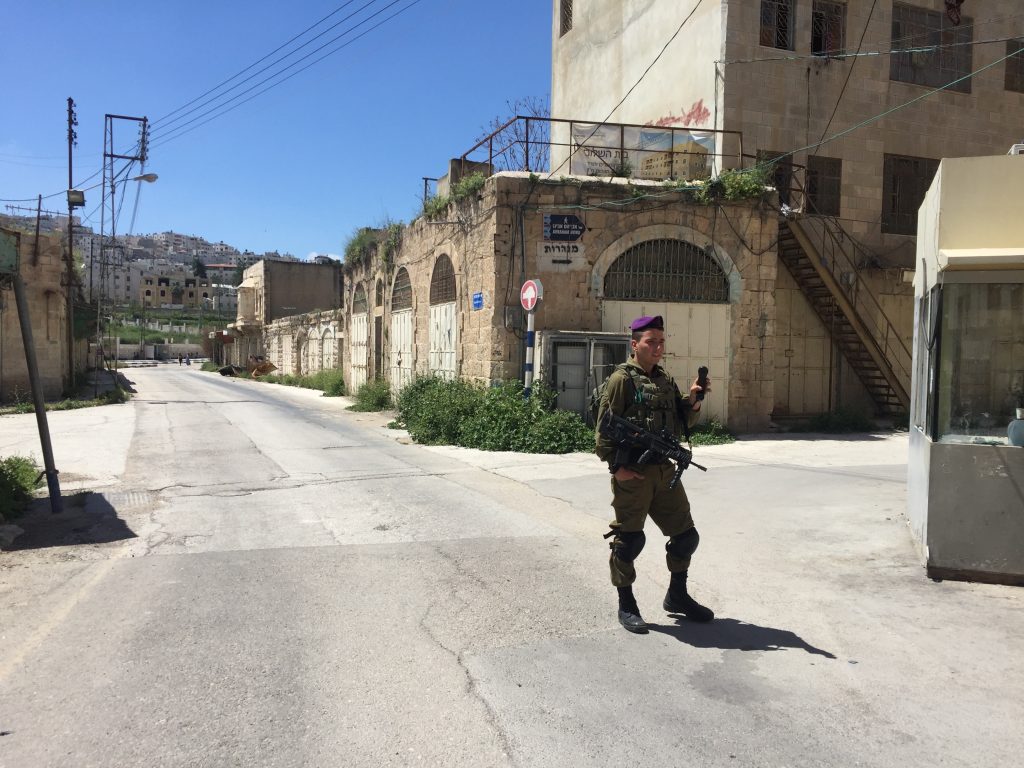Another day, another divided city. On Wednesday we drove south to Hebron, where a population approaching half a million people is divided by a pocket of settlers. The city is divided between H1 (Palestinian) and H2 (Israeli). How it has come to this has been a complex journey with atrocities on both sides, a familiar story of Palestinian residence and Jewish religious claims.


As we walked through the city centre the streets bustled with traders selling fruit, bread, most things in fact. Then we reached one of the most infamous sites in the West Bank. Shuhada Street, where suddenly the houses and shops were closed and a checkpoint blocked the way. This is one of 23 Israeli controlled checkpoints within 1 square-mile. Incidentally, Shuhada means martyr in Arabic.

Our guide Ra’ed Jabari pointed out the family business, a pharmacy, that had to be abandoned when the area was cut off. We didn’t go through the checkpoint but continued through the old market, surely one of the most striking in the Middle East had it not been for the divisions that scarred it. The Palestinians still trade there, but they do so under the protection of nets that shield them from whatever the settlers can find to throw at them.


Just off the market we are invited into a Palestinian home to see just how sharp the conflict is in this neighbourhood. In the living room, where the main window is blocked off, we hear of the family’s 12-year-old son, who was partially blinded by hydrochloric acid thrown at his face. We go upstairs to the roof, where we see the divide through a sea of metal and barbed wire. Below us are the IDF guards and, it seems, an angry settler. A young man, around 30 perhaps, is shouting in our direction then goes to remonstrate with the soldiers. “I don’t want to see you!”, we are told he was shouting.


I asked our guide if he had ever faced repercussions for showing people around the sensitive areas. He replied that he had both his legs broken by soldiers who were angered that he showed a group of Germans around.

Hebron was recognised by UNESCO as a Palestinian Heritage site in 2017 and just as we saw in Jerusalem the religious sites are pivotal to the conflict. The El Ibrahim Mosque or the Tomb of the Patriarchs has crucial significance in Judaism, Christianity and Islam, changing hands frequently over the centuries. Since 1967 the holy site has served as a mosque and a synagogue. But recently the holy site has been under the shadow of what happened on 25thFebruary, 1994. Baruch Goldstein, a religious extremist, walked into the mosque area and opened fire on the worshipping Muslims, killing 39 Palestinians and wounding many more. Goldstein himself was killed by the crowd, but that wasn’t end of the killing that day. In the ensuing riots more Palestinians lost their lives. The attack changed Hebron forever, leading to increased segregation, 1800 shop closures and an initial 6-week curfew for Palestinians.

Once out of the mosque we said goodbye to Ra’ed as we were now going into an area where he could not go. Shuhada Street, which had been closed to Palestinians after the massacre in 1994. We were met Achiya Schatz, the Communications Director of ‘Breaking the Silence’ an organisation for former Israeli soldiers, who wish to reveal their experiences while completing their national service.

It was as though we had wandered into a ghost town, the few remaining Palestinian dwellings had protective grills on the windows and the shop entrances were welded shut.


We gathered in a deserted side street, where we waited for the soldiers to escort us through the sterile zone. Achiya told us more of his experiences as a serving soldier. He was frequently sent into Palestinian homes at night for ‘mapping’ purposes. After these expeditions, which were hugely intrusive to the Palestinian families, the soldiers ‘felt good’ and that they had done the job. Achiya no longer felt good about what he had done, which is why he was here with us, a representative of Breaking the Silence.

As Achiya talked a settler walked past and shouted ‘Stop lying!’ and the IDF constantly moved us on, before finally escorting us through. Later on we went to the Meir Kahane Memorial Park in the Kiryat Arba settlement. There was more abuse here, but it seemed they just objected to us taking photos. We crossed the down-at-heel public area to find the grave of Baruch Goldstein. It had been kept as a shrine to Goldstein until 1999, when Israel passed a law to outlaw monuments to terrorists, so the shrine was scaled back. But the tombstone remained.

As we prepared to leave I heard the call to prayer drifting across the hillside and wondered about the poignancy of the scene. A killer of so many Muslims, now in his grave, in earshot of those verses of the Koran that drift over from the Palestinian neighbourhoods five times a day.

We travelled with Achiya a little further into the South Hebron Hills until we reached the Bedouin village, Umm Al Khair. Nearby was Carmel, an Israeli settlement which Achiya had helped to guard during his days in the IDF. The life experience for the two communities could not be more different. While life carries on as normal for the settlers the Bedouins suffer chronic water shortages. It is often observed that the chicken farm that settlers run has better access to water and electricity than Umm al Khair. Worse still, the community of 160 people have frequently had their homes demolished.

We were speaking to Awdah Al-Hathaleen in the community centre that the villagers had managed to construct. Awdah described coming home from school to find that his village had been demolished. He added that 46% of the children of Umm Al Khair suffered ‘demolition nightmares’. He said, “Peace means that people can sleep without being scared.”
On a positive note Awdah spoke of the need to work with internationals who could show solidarity with Palestinian cause. He also mentioned his dreams, which, for now, seem quite distant. One was to visit Jerusalem, another to go to the beach.
